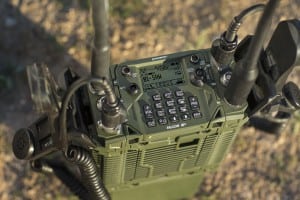L3Harris [LHX] is readying for the Army’s major Integrated Tactical Network evaluation later this summer, which will utilize its software-defined handheld and manpack radios, with its sights set on moving toward full-rate production and exploring the service’s interest in new high frequency radios.
Jeff Smith, L3Harris’ vice president of business development for communications systems, told Defense Daily
recently the company is looking at burgeoning opportunities for new ‘anti-jam, low probability of detection’ radios for the Army’s second tactical network modernization capability drop.

“We have had very good communication with the Network Cross Functional Team and [CFT Director] Gen. Gallagher. We’re very focused on the capability sets for the Army and what they’re doing with the Integrated Tactical Network. We have software-defined radios that are part of the critical design, not just the design itself. They’re critical to the design across all capability sets into the future,” Smith said.
L3Harris is currently providing its software-defined AN/PRC-163 handheld radios and AN/PRC-158 manpack radios to provide key pieces of the new Integrated Tactical Network under the Leader radio program, which also includes Collins Aerospace [UTX] and France’s Thales.
“The three companies, with our radios, will be part of the Integrated Tactical Network evaluation that’s going to take place late summer. And, quite frankly, that is critical for the Army and for us that it’s successful and we’re doing everything we can, working with the Network CFT, to make that successful,” Smith said.
Smith said a full-rate production decision for the two-channel Leader radios is likely for next year as the Army looks to field large quantities throughout the service to solidify the Integrated Tactical Network.
“The expectation is that they will start moving toward full-rate production in both the Leader radio and the Manpack radio, which will then enable them to field the first three or four bridgade combat teams with these new radios,” Smith said.
Army network modernization officials told Defense Daily in January initial equipment orders for the Army’s first tactical network modernization capability drop (CAPSET 21) and prototype deals for the second capability set (CAPSET 23) will both likely be placed before the end of this fiscal year, with CAPSET 23 to include a focus on “new waveforms that offer resiliency in an electronic warfare environment” (Defense Daily, Jan. 21).
“When you look forward to CAP SET 23, what the Army is looking for is they want to close the gap on resiliency. We are working very closely with the network modernization team and with the C5ISR Center and Army Futures Command to help the Army resolve that problem. One of their focuses in CAPSET 23, and where they’re going to be putting some of their money, is in this area,” Smith said. “We are starting to see a trend of keen interest in low probability of inception and detection and anti-jam capabilities. We are working on that. We have some initiatives underway.”
Smith noted the Army has also expressed interest in L3Harris’ new AN/PRC-160 High Frequency radio, which he said offers a large upgrade over the legacy AN/PRC-150 to include the ability to send digital photos.
“We’ve had it in a number of demonstrations with the Army already as part of the Integrated Tactical Network and some of the evaluations that they’re doing. A lot of their reconnaissance units are looking at this radio. They’re looking at this radio as alternative means to satellite [communications],” Smith said.
In December, L3Harris received a $50 million order from the Marine Corps for the AN/PRC-160 radios (Defense Daily, Dec. 6).